Looking to up your Twitter game as we head into the holiday shopping season?
While it may not have as many total users as some other platforms, Twitter is still highly influential, with many industry leaders and journalists using Twitter as a key research and outreach tool.
That means that your key messages can get amplified beyond Twitter to much larger audiences, and if you can get it right, this can be a hugely valuable marketing play to boost brand and product awareness.
So what are the key Twitter best practices to note? Here are five tips.
1. Research relevant hashtags
Hashtags are not as important as they used to be, but they do still play a key role in helping to organize tweet discussions, which can highlight how people are engaging in topic-specific elements. As such, it’s worth noting the key hashtags that people are using in your niche.
To assess this, first, you need to get a listing together of hashtags used in your target sector. You can start with general tags that you’re aware of, or those being used by known influencers, other brands, etc.
For this experiment, let’s say we’re selling basketball shoes – using a tool like Hashtagify, you can find info on hashtag popularity, based on usage, as well as related tags.
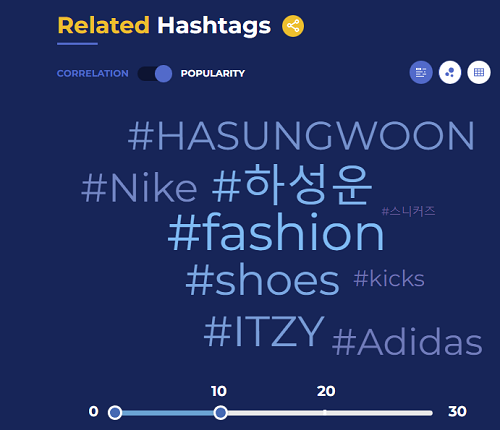
Research each tag and its related recommendations, build an expanded list of all these examples, then sort that listing by popularity score (based on overall usage), and you’ll end up with a fairly comprehensive collection of the top hashtags used by people tweeting in your niche.
2. Research your target accounts
As noted, on Twitter, it’s less about reaching the masses directly and more about getting your content in front of key influencers who can then help to amplify your message to a broader audience.
Of course, if you can reach the maximum number of people straight up, that’s great too, but again, Twitter’s total audience of 238 million monetizable daily active users is far smaller than Instagram or Facebook, which both see over a billion active users.
With this in mind, what can be a more effective amplification tactic is to research the people, profiles and publications that you want to reach, who can then help to boost your messaging.
How do you do this?
First, you need to research the most influential voices in your niche.
One way you can do this is via Twitter search – you can use Twitter’s advanced search operands, for example, to look up the key profiles in your industry and region.
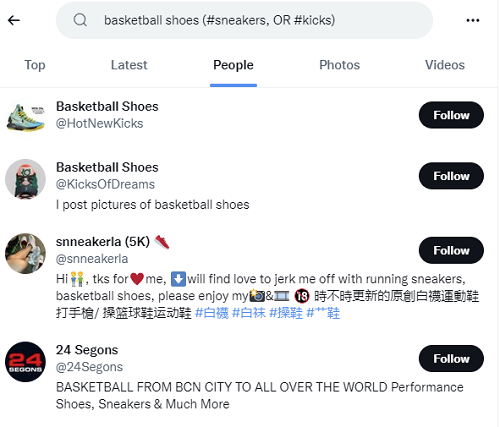
As you can see in this example, I’ve used some of the top hashtags from the previous step in my search, helping to hone in on the key accounts that are tweeting about my focus topic.
You can also use a tool like BuzzSumo to research top influencers on any topic.
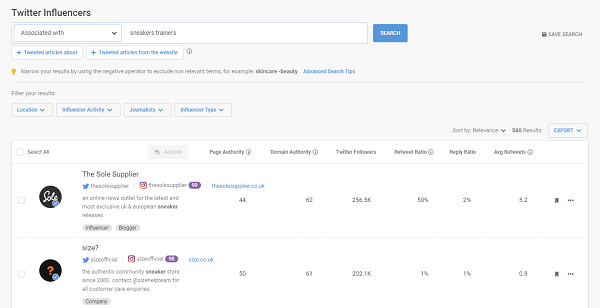
This research will give you a solid listing of the various Twitter profiles that you’d ideally love to get your brand messaging in front of.
You can then dig further into where these profiles are looking, by analyzing who they follow for the latest industry news.
Using Followerwonk, for example, you can enter in three Twitter handles at a time, and get info on which accounts they follow in common.

Hone in on those accounts, and you’ll get a better idea of which Twitter profiles are viewed as news sources in your niche. Identify any key publications from these lists, and that will provide a clear indicator of which publishers you want to connect with, and ideally, secure coverage from, to get in front of key influencers in your sector.
So again, the idea here is less about reaching potential customers directly via tweet, and more about maximizing exposure through key accounts that can then get you in front of top influencers in your niche.
3. Tweet structure
Now that you know who you’re trying to reach, you next need to understand what works best in terms of grabbing attention, and getting noticed in the busy tweet stream.
Twitter advises that brands should stick to its ‘three C’s’ approach for optimal tweeting:
- Concise
- Clear
- Conversational
You’ve only got 280 characters, so you need to be concise, but it’s important to also be clear, and to look to prompt discussion among your audience.
Twitter also published these guidance notes earlier this year:
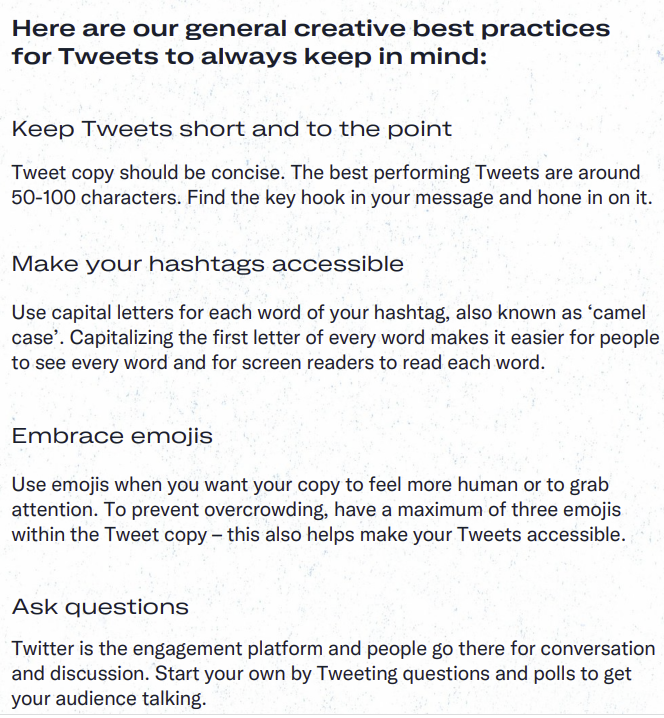
In terms of content formats, tweets with video see the most engagement, followed by tweets with GIFs, photos than plain text.
And again, hashtag usage can be variable. If you’re sharing a link that you want people to click, then hashtags can distract from that, by giving people more things to click in the tweet. In instances like this, it may be better to not use any hashtags at all, but based on step one, you also have a solid list of the top hashtags, based on usage, to refer to for your experiments.
Twitter also advises that a strong call to action can be effective:
“Be clear and straightforward with your desired action and explicitly say “follow us”, “click to read more”, or “reply with your favorite [insert here]”.
There are variables to this too – it can be overly pushing or promotional to be so direct. But it’s another element to experiment with in your tweets.
4. Best times to tweet
In order to reach the maximum number of people, it’s also worth considering when your target audience is most active in the app.
There are generic best advice notes on this – Sprout Social’s analysis of best times to tweet from earlier this year suggests that Mondays, Tuesdays, Wednesdays, Fridays and Saturdays, between 9 am and 12pm, are the best tweeting times.
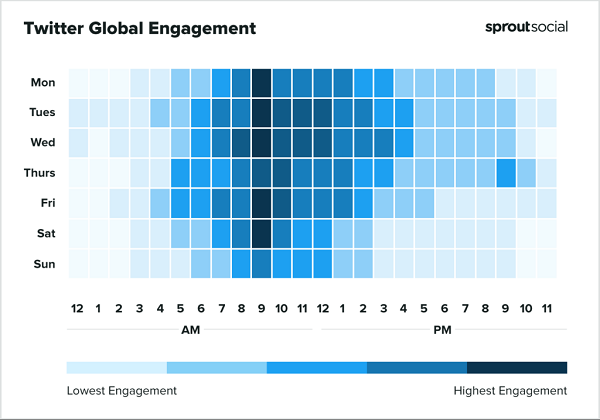
But if you want to get more specific, you can analyze individual Twitter handles to see when their audience is most active, including your own, using Followerwonk.
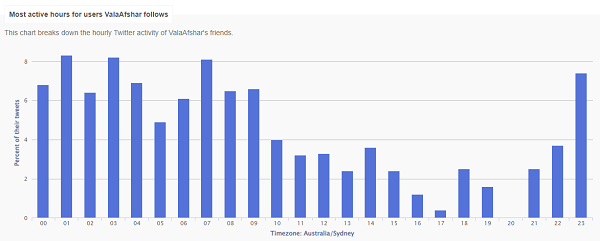
That will give you a clearer idea of when more of your audience is active, or when more of the audience that you want to reach is online, based on your research handles.
Schedule, experiment, and see what results you get based on this insight.
5. Professional Profiles
It’s not a ‘must-have’ just yet, but Twitter’s Professional Profile option is definitely worth also considering to maximize your tweet opportunities.
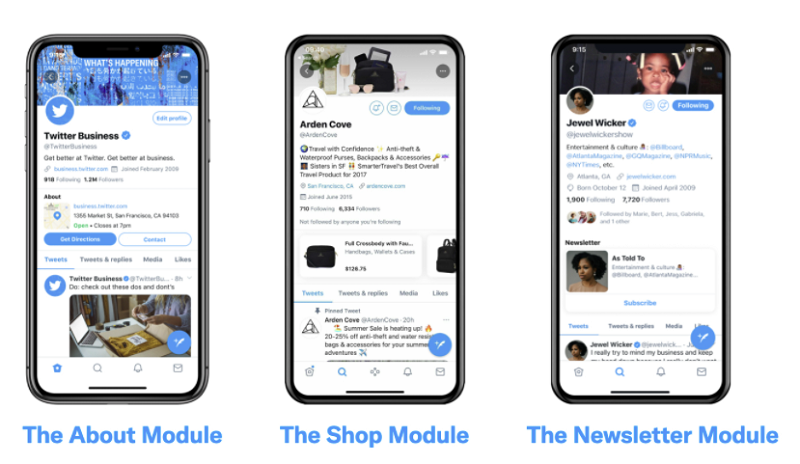
Twitter made its Professional Profile option available to all brands and creators back in March, which enables you to add various business info panels to your Twitter page, including business category, location, contact info and more.
That can add an extra level of credibility to your Twitter presence, along with the additional info panels and tools, which can help to boost brand and product awareness.
Realistically, more people are going to see your tweets than your profile, so again, it’s not a must-have, as such. But it may be worth exploring, and as Twitter adds even more elements to its Professional account suite, it could be an increasingly valuable consideration for brands.
You can learn more about Professional Profiles here.
These notes will help you improve your Twitter approach heading into the new year, and capitalize on key discussions and trends, which could give your Twitter outreach a big boost.
But the key note is in how you look at Twitter – it’s not going to give you the direct reach benefits that other apps can, but it can help to boost your brand awareness and community efforts, when used right.
Hopefully, these tips get you thinking about how to boost your Twitter presence.



